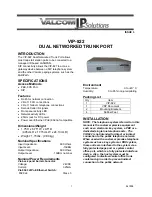
P-791R v2 Support Notes
DSL FAQ
1. How does DSL compare to Cable modems?
DSL provides a dedicated service over a single telephone line; cable modems
offer a dedicated service over a shared media. While cable modems have
greater downstream bandwidth capabilities (up to 30 Mbps), that bandwidth is
shared among all users on a line, and will therefore vary, perhaps dramatically,
as more users in a neighborhood get online at the same time. Cable modem
upstream traffic will in many cases be slower than DSL, either because the
particular cable modem is inherently slower, or because of rate reductions
caused by contention for upstream bandwidth slots. The big difference
between DSL and cable modems, however, is the number of lines available to
each. There are no more than 12 million homes passed today that can support
two-way cable modem transmissions, and while the figure also grows steadily,
it will not catch up with telephone lines for many years. Additionally, many of
the older cable networks are not capable of offering a return channel;
consequently, such networks will need significant upgrading before they can
offer high bandwidth services.
2. How do I know the DSL line is up?
You can see the DSL LED on the P-791R v2's front panel is on Green when
the DSL physical layer is up.
3. How does the P-791R v2 work on a noisy DSL?
Depending on the line quality, the P-791R v2 uses "Fall Back" and "Fall
Forward" to automatically adjust the date rate.
4. Does the VC-based multiplexing perform better than the LLC-based
multiplexing?
Though the LLC-based multiplexing can carry multiple protocols over a single
VC, it requires extra header information to identify the protocol being carried
on the virtual circuit (VC). The VC-based multiplexing needs a separate VC for
carrying each protocol but it does not need the extra headers. Therefore, the
VC-based multiplexing is more efficient.
5. How do I know the details of my DSL line statistics?
In WEB Configurator
, Maintenance -> Diagnostic -> DSL Line -> DSL Line
Status:
19
All contents copyright © 2007 ZyXEL Communications Corporation.
















































